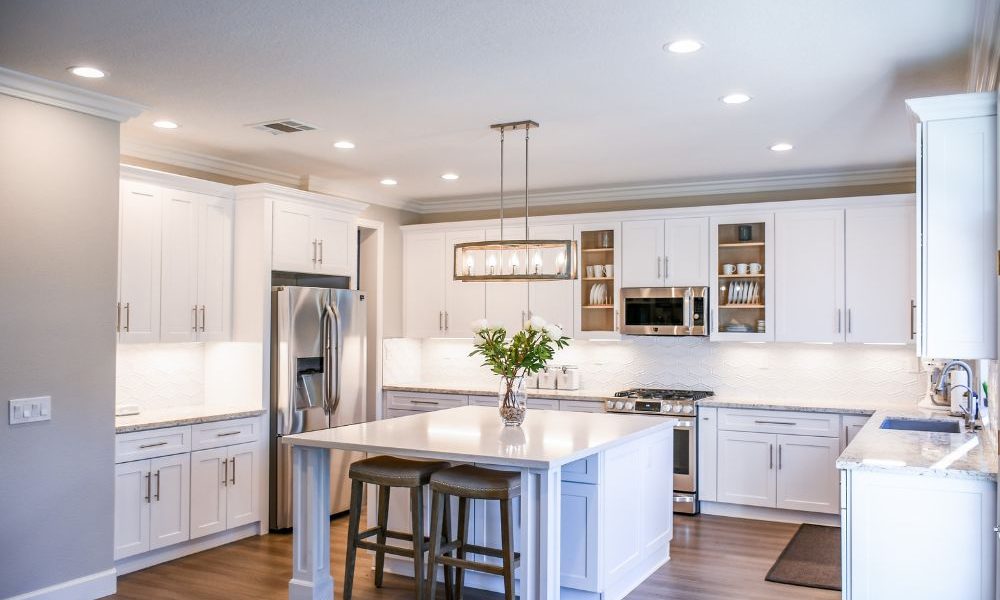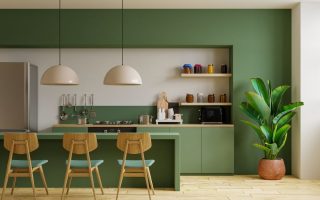Lighting is often considered the unsung hero of any room, especially in the kitchen. It can transform a space from ordinary to extraordinary and is essential for creating a welcoming and functional environment. This guide will help you understand the different types of kitchen lighting, how to layer them effectively, and how to choose the best fixtures to suit your style and needs.
Understanding the Importance of Kitchen Lighting
Lighting plays a crucial role in the kitchen, where both functionality and aesthetics are key. As Lee Broom, a renowned lighting designer, aptly puts it, “Lighting is the unsung hero of any room. It can transform a space from ordinary to extraordinary, and it’s essential for creating a welcoming and functional kitchen” (Source: Elle Decor).
Personal Anecdote
When I renovated my kitchen, I underestimated the impact of lighting. It wasn’t until I added layered lighting – a mix of ambient, task, and accent lights – that the space truly came alive. The right lighting made cooking more enjoyable and the kitchen more inviting.
Types of Kitchen Lighting
To create a well-lit kitchen, you need to incorporate three types of lighting: ambient, task, and accent lighting.
Ambient Lighting
Ambient lighting provides general illumination for the room. It’s the foundation of your kitchen lighting scheme and should ensure the space is evenly lit. Common fixtures for ambient lighting include recessed lights, flush mounts, and large ceiling fixtures.
Task Lighting
Task lighting is essential for areas where specific activities take place, such as food preparation and cooking. This type of lighting should be bright enough to prevent eye strain and shadows. Under-cabinet lights, pendant lights over islands, and track lighting are excellent choices for task lighting.
Accent Lighting
Accent lighting is used to highlight certain features of the kitchen, such as architectural details, artwork, or unique backsplash designs. It adds depth and dimension to the space. Examples include LED strips under cabinets, spotlights, and small pendants.
Sally Storey, another prominent lighting designer, emphasizes the importance of layered lighting: “In a kitchen, it’s important to have a layered lighting scheme that includes ambient, task, and accent lighting. This will create a well-lit and inviting space that is both functional and beautiful” (Source: John Cullen Lighting).
Making the Most of Natural Light
Natural light is a precious resource in any home, and it’s especially important in the kitchen. Maximizing natural light can make your kitchen feel brighter and more spacious.
Personal Anecdote
In my kitchen, I installed a large window above the sink and used light-colored countertops and backsplashes to reflect the natural light. The difference was remarkable – the kitchen felt more open and welcoming.
Mark McMenamin, an architect, advises: “Natural light is a precious resource in any home, and it’s especially important in the kitchen. Make the most of it by using light-colored countertops and backsplashes, and by installing skylights or larger windows” (Source: Architectural Digest).
Choosing the Right Fixtures
Selecting the right fixtures is crucial for achieving the desired lighting effect. Here are some popular options for kitchen lighting:
Pendants
Pendants are versatile and stylish. They work well over kitchen islands, dining areas, or as accent lighting. You can choose from a wide range of designs, from modern to rustic, to match your kitchen’s decor.
Recessed Lighting
Recessed lights, also known as can lights, provide unobtrusive ambient lighting. They’re ideal for kitchens with low ceilings or for creating a clean, modern look.
Under-Cabinet Lighting
Under-cabinet lights are perfect for task lighting. They illuminate countertops and eliminate shadows, making it easier to see what you’re doing. LED strips or puck lights are popular choices.
Track Lighting
Track lighting is flexible and can be adjusted to direct light where it’s needed most. It’s a great option for both ambient and task lighting.
Sconces
Wall sconces can add a decorative touch and provide additional lighting for specific areas, such as next to a sink or above open shelving.
Rebecca Weir, an interior designer, encourages experimentation: “Don’t be afraid to experiment with different types of lighting fixtures in your kitchen. Pendants, sconces, and track lighting can all be used to create a unique and stylish look” (Source: House Beautiful).
Practical Tips for Kitchen Lighting
Use Dimmers
Dimmers allow you to adjust the brightness of your lights, creating different moods for different times of the day or activities. They’re especially useful for ambient and accent lighting.
Consider Energy Efficiency
Opt for LED lights, which are energy-efficient and long-lasting. They’re available in a variety of styles and can provide both warm and cool lighting.
Plan Your Lighting Layout
When planning your kitchen lighting, consider the layout and how you use the space. Make sure there’s adequate lighting for all work areas and that the fixtures are placed to minimize shadows.
Ensure Safety
Proper lighting is essential for safety, especially in areas where you handle sharp tools and hot surfaces. Make sure your task lighting is bright and well-placed to prevent accidents.
Young Huh, a professional organizer and interior designer, highlights the importance of good lighting in small kitchens: “Good lighting can make a small kitchen feel larger and more open. Use under-cabinet lighting to illuminate countertops and backsplashes, and install recessed lighting in the ceiling to create a bright and airy feel” (Source: The Neat Method).
Personalizing Your Kitchen Lighting
Lighting is a personal choice, and it should reflect your style and preferences. Here are some ideas to personalize your kitchen lighting:
Statement Fixtures
Choose a statement fixture, such as a chandelier or a set of pendant lights, to add a touch of personality and become a focal point in your kitchen.
Color Temperature
The color temperature of your lights can affect the overall feel of your kitchen. Warm white (2700K-3000K) creates a cozy, inviting atmosphere, while cool white (3500K-4100K) is more energetic and suitable for task lighting.
Smart Lighting
Smart lighting systems allow you to control your lights with your smartphone or voice commands. You can adjust the brightness, color, and schedule your lights to turn on and off automatically.
Personal Anecdote
I recently upgraded to smart lighting in my kitchen. It’s incredibly convenient to control the lights with my phone, especially when my hands are full. Plus, I love being able to change the color temperature depending on the time of day.
The Impact of Lighting on Mood and Behavior
Lighting not only affects the look of your kitchen but also your mood and behavior. According to the Lighting Research Center (LRC), different types of lighting can influence our mood, energy levels, and productivity. Warm, dimmable lighting is best for creating a relaxing atmosphere, while bright, cool lighting is ideal for task-oriented activities.
Conclusion
Lighting is a crucial element in kitchen design. By understanding the different types of lighting, maximizing natural light, choosing the right fixtures, and personalizing your space, you can create a kitchen that is both functional and beautiful. As you plan your kitchen lighting, keep in mind the advice of top designers and experts to ensure your space is well-lit and welcoming.
With the right lighting, your kitchen can be transformed into a space where you love to cook, entertain, and spend time with family and friends. Whether you’re renovating your entire kitchen or just updating the lighting, these tips and insights will help you create a bright and inviting space that meets your needs and reflects your personal style.




